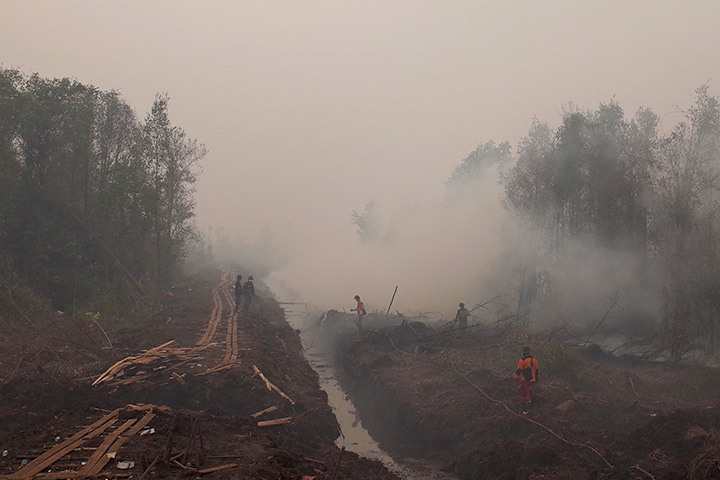Forest fire haze from Indonesia detected in Malaysia – AP News

Transboundary Haze from Indonesian Fires: A Report on Sustainable Development Goal Implications
Incident Overview
A recent environmental event has seen haze originating from forest and peatland fires in Sumatra, Indonesia, cross international borders into Malaysia. This incident highlights significant challenges to regional sustainability and development.
- Origin: Forest and peatland fires in Indonesia’s Riau province, with over 140 fires reported.
- Affected Areas: Rokan Hilir and Rokan Hulu districts in Riau are severely impacted, with approximately 46 hectares burned.
- Transboundary Impact: Satellite imagery from the Meteorology, Climatology and Geophysics Agency confirmed haze movement from Indonesia, reaching Kemang Bay in Malaysia’s Negeri Sembilan state.
Challenges to Sustainable Development Goals (SDGs)
The recurring fires and resulting haze present a direct threat to the achievement of several key Sustainable Development Goals.
-
SDG 3: Good Health and Well-being
- Air quality in affected regions has worsened due to thick, choking smoke.
- This poses direct health risks to populations in both Indonesia and Malaysia, undermining public health objectives.
-
SDG 15: Life on Land
- The fires cause significant destruction of terrestrial ecosystems, including vital forests and carbon-rich peatlands.
- This event contributes to land degradation and biodiversity loss, directly contravening the goal of protecting and restoring life on land.
-
SDG 11: Sustainable Cities and Communities
- The haze has severely reduced visibility to as low as one kilometer in parts of Riau.
- This pollution disrupts daily life, transportation, and economic activity, compromising the safety and sustainability of communities.
-
SDG 13: Climate Action
- Forest and peatland fires are a major source of greenhouse gas emissions, contributing directly to climate change.
- These annual fires, often occurring during dry spells, represent a significant setback for climate mitigation efforts.
Governance and International Cooperation
The incident underscores critical issues in governance and the necessity for international partnerships to address shared environmental threats.
-
SDG 16: Peace, Justice, and Strong Institutions
- The annual nature of the fires and transboundary haze strains diplomatic relations between Indonesia and its neighbors, including Malaysia and Singapore.
- Issues of accountability persist, with Indonesian authorities often attributing the fires to illegal land-clearing practices by plantation owners and farmers.
-
SDG 17: Partnerships for the Goals
- The cross-border nature of the haze necessitates robust international cooperation for monitoring, prevention, and response.
- Effective management of this recurring crisis requires a coordinated partnership between Indonesia, Malaysia, and other affected nations to address the root causes and mitigate impacts.
Analysis of Sustainable Development Goals in the Article
1. Which SDGs are addressed or connected to the issues highlighted in the article?
The article discusses issues that are directly and indirectly connected to several Sustainable Development Goals (SDGs). Based on the content, the following SDGs are relevant:
- SDG 3: Good Health and Well-being: The haze and air pollution resulting from the fires pose a significant risk to human health.
- SDG 11: Sustainable Cities and Communities: The article highlights how the haze affects urban and populated areas, impacting air quality and daily life.
- SDG 15: Life on Land: The core issue discussed is the destruction of terrestrial ecosystems, specifically forests and peatlands, through fires and land clearing.
- SDG 17: Partnerships for the Goals: The transboundary nature of the haze, affecting neighboring countries like Malaysia, underscores the need for international cooperation to address the problem.
2. What specific targets under those SDGs can be identified based on the article’s content?
Several specific targets can be identified by analyzing the problems described in the article:
-
SDG 3: Good Health and Well-being
- Target 3.9: By 2030, substantially reduce the number of deaths and illnesses from hazardous chemicals and air, water and soil pollution and contamination.
Explanation: The article explicitly mentions “choking smoke” and that “haze has caused the air quality in Riau to worsen.” This directly relates to air pollution, which is a key component of this target. The haze is a form of air contamination that can lead to respiratory illnesses.
- Target 3.9: By 2030, substantially reduce the number of deaths and illnesses from hazardous chemicals and air, water and soil pollution and contamination.
-
SDG 11: Sustainable Cities and Communities
- Target 11.6: By 2030, reduce the adverse per capita environmental impact of cities, including by paying special attention to air quality and municipal and other waste management.
Explanation: The article states that “A number of areas in Indonesia’s Riau province were still covered by thick haze” and that this pollution reduced visibility and worsened air quality. This highlights the adverse environmental impact on communities and cities, directly aligning with the goal of improving urban air quality.
- Target 11.6: By 2030, reduce the adverse per capita environmental impact of cities, including by paying special attention to air quality and municipal and other waste management.
-
SDG 15: Life on Land
- Target 15.2: By 2020, promote the implementation of sustainable management of all types of forests, halt deforestation, restore degraded forests and substantially increase afforestation and reforestation globally.
Explanation: The article’s central theme is “forest and peatland fires” and the practice of setting fires for “land-clearing.” This represents a failure to sustainably manage forests and contributes directly to deforestation and forest degradation, which this target aims to halt. - Target 15.3: By 2030, combat desertification, restore degraded land and soil, including land affected by desertification, drought and floods, and strive to achieve a land degradation-neutral world.
Explanation: The burning of peatlands is a severe form of land degradation. The article notes that “fires that burned about 46 hectares” contribute to the degradation of land and soil, an issue directly addressed by this target.
- Target 15.2: By 2020, promote the implementation of sustainable management of all types of forests, halt deforestation, restore degraded forests and substantially increase afforestation and reforestation globally.
-
SDG 17: Partnerships for the Goals
- Target 17.14: Enhance policy coherence for sustainable development.
Explanation: The Indonesian government’s practice of blaming farmers and plantation owners for fires, while also denying that these fires cause haze in neighboring countries, points to a lack of policy coherence. A coherent policy would integrate environmental protection (preventing fires) with agricultural and economic policies. - Target 17.16: Enhance the global partnership for sustainable development… to support the achievement of the sustainable development goals in all countries.
Explanation: The article highlights that the haze is a transboundary issue, as it “was detected in Malaysia” and has historically “strain[ed] relations with neighboring countries.” This situation calls for a robust partnership between Indonesia, Malaysia, and other affected nations to manage and prevent the fires, aligning with the goal of international cooperation.
- Target 17.14: Enhance policy coherence for sustainable development.
3. Are there any indicators mentioned or implied in the article that can be used to measure progress towards the identified targets?
The article provides several quantitative and qualitative indicators that can be used to measure progress:
-
Indicators for SDG 3 and SDG 11
- Air Quality Level: The article implies this indicator by describing “thick haze,” “choking smoke,” and “worsen[ed] air quality.” Progress would be measured by improved air quality indices in affected regions.
- Reduced Visibility: The article mentions that haze “reduced visibility to as low as one kilometer (half a mile).” This is a direct, measurable indicator of the severity of air pollution.
- Geographic Spread of Haze: The use of “satellite imagery from the Meteorology, Climatology and Geophysics Agency” to detect haze moving to Malaysia is an indicator of the transboundary impact. A reduction in this spread would signify progress.
-
Indicators for SDG 15
- Number of Hotspots/Fires: The article provides specific numbers, such as “more than 140 forest and peatland fires” and a previous count of “294 hotspots.” Tracking the number of hotspots over time is a key indicator of progress in preventing deforestation and land degradation.
- Area of Land Burned: The article states that fires “burned about 46 hectares in the two districts.” The total area of forest and peatland burned annually is a direct indicator of the extent of land degradation (Indicator 15.3.1: Proportion of land that is degraded over total land area).
-
Indicators for SDG 17
- Status of International Relations: The article describes how the issue “strain relations with neighboring countries” and mentions Indonesia’s denial of responsibility. The state of diplomatic dialogue, joint task forces, and official agreements between Indonesia and its neighbors (like Malaysia and Singapore) can serve as a qualitative indicator of partnership effectiveness.
4. Summary Table of SDGs, Targets, and Indicators
| SDGs | Targets | Indicators Identified in the Article |
|---|---|---|
| SDG 3: Good Health and Well-being | 3.9: Reduce deaths and illnesses from air pollution and contamination. |
|
| SDG 11: Sustainable Cities and Communities | 11.6: Reduce the adverse per capita environmental impact of cities, paying special attention to air quality. |
|
| SDG 15: Life on Land |
15.2: Halt deforestation and restore degraded forests.
15.3: Combat desertification and restore degraded land. |
|
| SDG 17: Partnerships for the Goals |
17.14: Enhance policy coherence for sustainable development.
17.16: Enhance the global partnership for sustainable development. |
|
Source: apnews.com

What is Your Reaction?
 Like
0
Like
0
 Dislike
0
Dislike
0
 Love
0
Love
0
 Funny
0
Funny
0
 Angry
0
Angry
0
 Sad
0
Sad
0
 Wow
0
Wow
0













































































